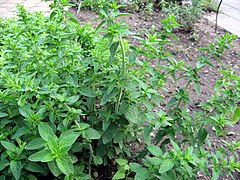Oregano
| Habit | herbaceous
| |
|---|---|---|
| Height: | ⇕ | 30 cm"cm" can not be assigned to a declared number type with value 30. to 45 cm"cm" can not be assigned to a declared number type with value 45. |
| Lifespan: | ⌛ | perennial |
| Exposure: | ☼ | sun |
|---|---|---|
| Water: | ◍ | moderate, dry |
| Features: | ✓ | evergreen, fragrance, edible, drought tolerant |
| USDA Zones: | 5 to 10 |
|
Origanum > |
vulgare > |
L. > |
Oregano or Pot Marjoram (Origanum vulgare) is a species of Origanum, native to Europe, the Mediterranean region and southern and central Asia. It is a perennial herb, growing to 20-80 cm tall, with opposite leaves 1-4 cm long. The flowers are purple, 3-4 mm long, produced in erect spikes. Its name derives from the Greek origanon.
Read about Oregano in the Standard Cyclopedia of Horticulture
|
|---|
|
Origanum vulgare. Linn. Rootstocks nearly horizontal: plant more or less hairy: Lvs. stalked, broadly ovate, sub- serrate or entire, broadly rounded at the base or sub- cordate: fls. purplish (varying to pink or nearly white), in corymbed clusters or short spikes; bracts purplish, about the length of the calyx; corolla longer than calyx; 2 or 4 of the stamens exserted.—Cult. in old gardens; also wild along eastern roadsides and in fields, naturalized from Eu. An erect herb, 1-2½ ft. high, aromatic. It runs into several forms, one of them being var. aureum, Hort., with golden or yellow foliage.
|
Cultivation
The subspecies of oregano Origanum vulgare hirtum is an important culinary herb. It is particularly widely used in Greek and Italian cuisines. It is the leaves that are used in cooking, and the dried herb is often more flavourful than the fresh.Template:Fact
It has an aromatic, warm and slightly bitter taste. It varies in intensity; good quality is so strong that it almost numbs the tongue, but the cultivars adapted to colder climates have often unsatisfactory flavour. The influence of climate, season and soil on the composition of the essential oil is greater than the difference between the various species.
The related species Origanum onites (Greece, Asia Minor) and O. heracleoticum (Italy, Balkan peninsula, West Asia) have similar flavours. A closely related plant is marjoram from Asia Minor, which, however, differs significantly in taste, because phenolic compounds are missing in its essential oil. Some breeds show a flavour intermediate between oregano and marjoram.
Propagation
Pests and Diseases
Varieties
There are a number of subspecies of oregano. For example, O. vulgare hirtum (Italian oregano), O. vulgare gracile, as well as cultivars, with each evincing distinct flavours.[1]
Other plants called oregano
Mexican oregano, Lippia graveolens (Verbenaceae) is closely related to lemon verbena. It is a highly studied herb that is said to be of some medical use and is common in curandera female shamanic practices in Mexico and the Southwestern United States. Mexican oregano has a very similar flavour to oregano, but is usually stronger. It is becoming more commonly sold outside of Mexico, especially in the United States. It is sometimes used as a substitute for epazote leaves; this substitution would not work the other way round.
Several other plants are also known as oregano in various parts of Mexico, including Poliomintha longiflora, Lippia berlandieri, and Plectranthus amboinicus (syn. Coleus aromaticus), also called Cuban oregano.
















